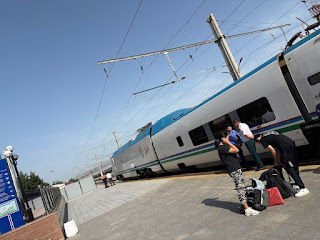Travelogue - Samarkand
As we stepped off the high-speed Afrosiyob train from Tashkent, our guide greeted us in Samarkand an—a city as ancient as Rome, once a vital crossroads on the Silk Road, and a true melting pot of civilizations. This is Samarkand: enigmatic, storied, and endlessly fascinating. We checked in to our hotel, Hotel Samaria Resorts & Spa, near Registan Square
.jpeg) |
| Silk Road Trade Routes converging @Sogdiana / Samarkand |
The Silk Road’s Heart: Sogdiana and Samarkand
The Silk Road conjures images of caravans winding through mountains and deserts, and Samarkand—once known as Sogdiana—was where many of these routes converged. I expected a city as bustling as Alexandria, but Samarkand surprised me with its neatness, spaciousness, and welcoming atmosphere. The influence of Soviet rule is still visible in the city’s broad avenues and enduring infrastructure. Many medical and technical institutes from Soviet times continue to thrive, and during our stay, we dined at a restaurant run by Indian students, filled with their compatriots studying in the city.
 |
| Afrosiyob - High Speed Train @ Samarkand |
More Than Silk: The Riches of the Silk Road
While silk is the Silk Road’s namesake, it was far from the only prized commodity. The Fergana Valley near Samarkand, as well as regions in Kazakhstan and Turkmenistan, were renowned for their exceptional horses. Traders also coveted lapis lazuli—the deep blue “god stone” found in Uzbekistan and Afghanistan—along with mulberry-paper, Indian spices, and much more. Samarkand’s markets once buzzed with goods and people from across the world: Indians, Greeks, Persians, Chinese, Mongols, Turks, and Romans all mingled here.
 |
| Registan Square @ Night |
Trade and Culture: Shared Heritage
Trade has always been a catalyst for cultural exchange. Uzbek dishes like plov (pilaf) and samsa bear a striking resemblance to Indian pulao and samosa. The Uzbek language is peppered with words from Turkic and Persian, and the leisurely tea culture echoes that of Turkey. Though Uzbekistan is predominantly Muslim, churches can also be found, reflecting its diverse history.
Layers of History: From Sogdiana to the Timurids
Samarkand’s story spans many eras. From Alexander the Great to Genghis Khan, the city was a center of learning and commerce. The Mongol invasion nearly destroyed it, but Samarkand reached new heights under Timur (Tamerlane). Timur’s legacy is deeply respected here, as is that of his descendant Babur, founder of the Mughal dynasty. Interestingly, February 14th is celebrated in Uzbekistan not as Valentine’s Day, but as Babur’s birthday, honoring the author of the Baburnama, his memoir chronicling his struggles for Samarkand..
 |
| Ullugh Beg Statue near his observatory |
Ulugh Beg: Science and Scholarship
A statue of Ulugh Beg stands near his historic observatory, a reminder of Samarkand’s golden age of learning. Ulugh Beg, a Timurid sultan, was a renowned mathematician and astronomer who built one of the world’s great observatories, inspired by Tycho Brahe. The remnants of his sextant are reminiscent of India’s Jantar Mantar. In his time, madrasas were true centers of learning, where science, mathematics, medicine, philosophy, and history were taught alongside religion. The word “madrasa” simply means “place of study”—a far cry from its modern connotations in some regions. As religious dogma replaced open inquiry, the broader curriculum faded, a pattern seen in many societies where religion and science have clashed..
Registan Square: The Jewel of Samarkand
The Registan, with its dazzling blue domes and majestic madrasas, is Samarkand’s iconic centerpiece. By night, the square and the nearby Bibi-Khanym Mosque glow during the sound and light show, rivaling the grandeur of the Taj Mahal.
 |
| Samarkand's cultural tourism marketing |
Tourism: Potential Yet to Be Realized
While Samarkand has a modern Silk Road center for shopping and conferences, its tourism marketing focuses mainly on the Timurid era, missing the chance to showcase its full Silk Road heritage. Our day trip to Shahrisabz, aside from the towering statue of Timur, was somewhat underwhelming. However, Samarkand’s recent designation as the World Cultural Tourism Capital by the UNWTO offers hope for a broader celebration of its history.
A City in Transition
Samarkand feels like a young person eager to reclaim the glory of their ancestors, yet still searching for direction. The city left a deep impression—dynamic, proud, and on the cusp of rediscovering its unique place in the world.
And in a delightful twist of fate, we ran into the same Indian couple from our hotel in Tashkent at our hotel in Samarkand—proof that, in this crossroads of cultures, paths are always crossing.
Read my Travelogues

Comments